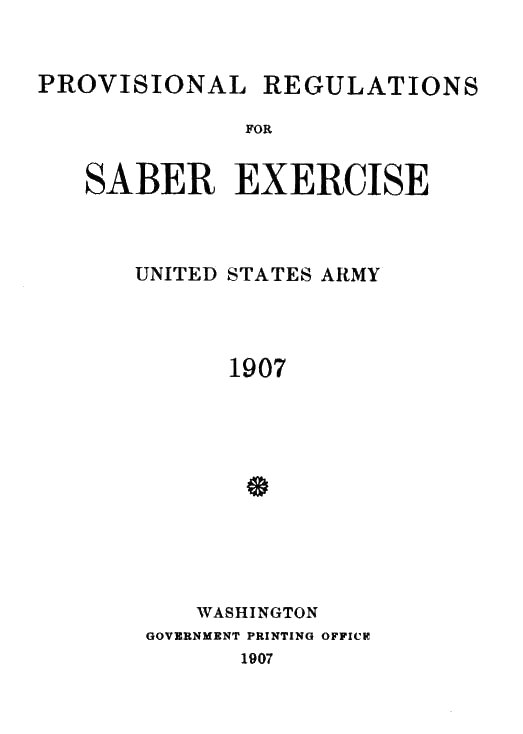REGULATIONS FOR SABER EXERCISE.
_____________________
GENERAL PRINCIPLES.
1. Exercises with the saber demand complete control of the body and serve not only to develop skill with that weapon but also to stimulate the mental qualities, such as coolness and presence of mind, courage, confidence, and quick decision in moments of danger.
2. The instruction is divided into (1) the school of saber exercise; and (2) exercises at will, or assault.
In the school exercises the preparatory movements, the cuts, thrusts, parries, and simple combinations thereof are taught. Precision and uniformity in the execution of the various exercises should be insisted upon. At first the exercises will be taught in detail or by the numbers in order that the instructor may correct faulty execution. The caution By the numbers, or Without the numbers, will be given as may be required. The exercises, as a rule, will be confined to those executed at command. Frequent short rests should be given.
3. In the exercises at will the various movements, cuts, thrusts, parries, and combinations are linked together in a bout or round, suitable action depending on the conduct of the opponent. Frequent practice at will, with different opponents and against various weapons, is necessary to establish skill in the use of the saber and the resulting confidence in the weapon.
4. The mental and physical qualities of each man must be taken into account and much will depend upon the personality of the instructor. The latter should by all means prevent the exercises from drifting into a perfunctory performance of the movements; higher authority should stimulate interest by arranging for competitions.
5. The first requisite for successful instruction in saber exercise is the existence in each organization of a sufficient number of competent
10 DESCRIPTION OF THE SABER, ETC.
instructors. When such are lacking, classes should be formed of officers and noncommissioned officers to undergo instruction by selected officers or others who have mastered the subject.
6. Instruction is given to squads of from four to twelve men, arranged at first in one line with intervals, and afterwards in two lines facing each other. A noncommissioned officer will be assigned to each squad as assistant instructor. An officer, as instructor, supervises the course of one or more squads. For the purpose of exercise, larger groups of men may be formed with distances (Par. 13).
The qualifications of assistant instructors should be tested before they are assigned to squads.
The education of the mounted soldier in swordsmanship is based on thoro instruction dismounted. With this foundation the good rider can, after a few lessons, be advanced to the mounted exercises at will.
 |
DESCRIPTION OF THE SABER AND
OTHER MEANS OF INSTRUCTION.
7. For instruction and exercise the regulation saber will be used whenever practicable. When the
men are arranged in two lines, and in the exercises at will, masks, special sabers, plastrons, and padded right-hand gauntlets will be necessary.
8. The saber is a cutting and thrusting weapon consistng of two pieces, namely, the blade and the hilt.
The blade has the following parts: Edge, false edge, back, grooves, point, and tang.
From hilt to point it may be considered as divided into three equal portions, namely, the heavy, middle, and light.
The hilt includes the gripes, guard, pommel, and base. The scabbard consists of the body, tip, band, rings, and springs.
The saber knot consists of tassel, strap, and sliding loops.
9. The special saber has a blade of tough wood and resembles the regulation saber in shape and length; or, a thin blade of steel with the end cut off square and padded with buckskin may be used. When special sabers are not available the exercise may be held with single sticks. These are about 3-1/2 feet long, three-quarters to 1 inch in diameter at the hilt, and taper slightly toward the point, A disk of sheet iron or stiff leather
|
|
|
|
|
|
|
DEFINITIONS. 11
should be secured so as to protect the hand. The proper balance may be given by loading the gripe with lead.
A target or dummy may be formed of a post about 5-1/2 feet high, padded so as to be about 20 inches in diameter. The top will represent the head; a painted ring 10 inches from the top will indicate the shoulders, and another, 2 feet lower down, the waist.
DEFINITIONS.
10. The right and left sides of the gripe are the right end left sides thereof in the position of carry saber.
The hand is in tierce when it holds the gripe, back of the hand up; in carte, when it holds the gripe, back of the hand down.
The gripe is held in full grasp when the fingers inclose it and the thumb is extended along its back.
Distance is the term applied to the amount of space separating two combatants.
(1) Normal distance, when either combatant can reach the other with the point of his saber at lunge. At guard the sabers would cross near the forward end of the middle third of the blades.
(2) Short distance, when the adversary can be reached without a lunge.
(3) Long distance, when a step in advance and a lunge are necessary.
(4) Out of distance, any distance greater than (3).
The directing line is the imaginary line passing thru the left heels of the combatants.
The plane of combat is the vertical plane thru the directing line. Engagement is the crossing of sabers by opponents, blade edge to edge, touching 8 to 12 inches from the point.
An opening is any uncovered portion of the body from the head to the hips.
An invite is the intentional offering of an opening with a view to inducing the opponent to attack.
Binding results from pressure against the opposing blade, the object being to offer or procure an opening.
Feints are simulated cuts or thrusts made with a view to inducing a parry and uncovering of the real point of attack. They are simple, double, etc., according to the number of movements.
The return is the counter attack, made instantly alter parrying the adversary's attack.
12 SABER EXERCISE ON FOOT
PART I.
Saber Exercise on Foot.
ARTICLE I.
PRELIMINARY MOVEMENTS
AND PREPARATORY EXERCISES WITHOUT SABERS.
11. The instruction without sabers develops in the men the proper elasticity, activity, and poise, without which the attainment of proficiency in swordsmanship is impossible.
The importance of the leg movements is equal to that of the saber exercises, and they usually are mastered with greater difficulty. Therefore, before beginning work with the saber the men should be drilled in the leg movements until they execute them properly and gracefully.
These exercises should be frequently repeated, because they confirm the men in the correct attitude and afford an excellent gymnastic exercise, increasing their strength and improving their bearing.
To Take Interval.
12. Being in rank at the halt: 1. To the right (left) take interval. 2. MARCH, 3. Squad, 4. HALT.
At the command march, all face to the right, and the first man steps off, followed in succession by the others at 3 yards. At the command halt, given when the last man has 3 yards, all halt and face to the front.
To assemble: 1. To the right (left) assemble, 2. MARCH. The right man stands fast; at the command march, the others face to the right, step out, close up, halt in their places and face to the front.
To Take Distance.
13. Being in rank at the halt: 1. Front take distance, 2. MARCH, 3. Squad, 4. HALT. At the command march, No. 1 moves straight
SABER EXERCISE ON FOOT 13
to the front; Nos. 2, 3, and 4 similarly move off in succession at 3 yards. The command halt should be given when No. 4 has his distance.
To assemble: 1. Form, 2 RANK. No. 1 stands fast; the others, at the command rank, move up into their places.
14. The normal interval (par. 12) and the normal distance (par. 13) is 3 yards. To take greater or less interval or distance, add at (so many) yards to the first command.
15. The squad having taken interval or distance, the instructor cautions: Leg movements, and commands: GUARD.
Half face to the left and quickly place the right heel in front of and against the left heel, the feet forming a right angle, with the right foot pointing straight to the original front; place the hands on the hips, fingers to the front, thumbs to the rear.
The shoulders remain square, chest slightly expanded, head erect and turned to the original front. (TWO) Raise the right foot about 1 inch, advance it quickly about once and a half its length to the front, and plant it smartly. The feet remain nearly at right angles to each other, knees equally bent; lower legs vertical; trunk erect, resting lightly on the hips and bearing equally on the legs; head erect and square to the front; right |
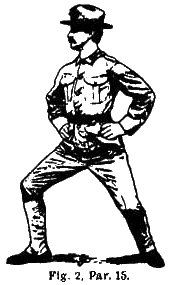 |
shoulder advanced and left shoulder refused, without restraint. This is the position of guard without arms.
ATTENTION. Take the position of the soldier.
16. The following movements are executed from the position of guard: ADVANCE.
At the command ad-vance, the right foot is quickly moved forward once its length and is promptly followed by the left foot for the same distance.
In executing these and all other leg movements the men must be instructed to use the legs only and not the body; for this reason the body must rest lightly on the hips. In the advance the weight is
14 SABER EXERCISE ON FOOT
quickly, but hardly perceptibly, transferred to the left leg. The right foot, just clearing the ground is forced forward by a slight extension and takes up the weight the moment it is placed on the ground, but without any inclination of the trunk. The left leg is brought up and the position of guard is resumed.
17. RETIRE.
At the command re-tire, move the left foot to the rear once its length, and follow quickly with the right, resuming the position of guard. The ball of the right foot is the last to leave the ground. The feet should be raised just enough to clear the ground; if
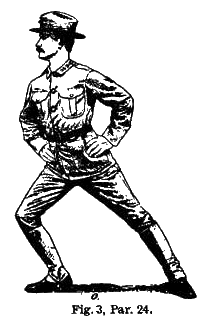
|
raised higher the position of the body will be disturbed.
18. 1. Front, 2. PASS.
Advance the left foot once and a half its length to the front of the right foot; then advance the right foot, resuming guard.
19. 1. Rear, 2. PASS.
Move the right foot once and a half its length to the rear of the left foot; then carry back the left foot, resuming guard.
20. 1. Right, 2. VOLT.
Face to the right, turning on the ball of the right foot; at the same time carry the left foot to its proper position, resuming guard.
21. 1. Left 2. VOLT.
Face to the left, turning on the ball of the right foot; at the same time carry the left foot to its proper position, resuming guard.
|
22. 1. To the Left, 2. TRAVERSE.
Move the left foot once its length to the left and 2 inches to the front; then quickly move the right foot half its length to the left and 2 inches to the front, resuming guard.
23. 1. To the Right, 2. TRAVERSE.
Move the right foot half its length to the right and 2 inches to the front; follow with the left foot once its length to the right and 2 inches to the front, resuming guard.
The traverses are used to circle around an enemy or to conform to his movements.
SABER EXERCISE ON FOOT 15
24. 1. EXTEND. At the command ex-tend, quickly straighten the left leg, bend the right knee until it is vertically over the toes, and incline the body slightly to the front; the weight is on the right leg. At the command guard, resume that position.
25. 1. LUNGE. Being in the position of guard, at the command lunge, advance the right foot once and a half its length and plant it firmly, the lower leg vertical, thigh nearly horizontal. The left leg is stiffly straightened, left foot flat on the ground; the feet are nearly at right angles to each other,
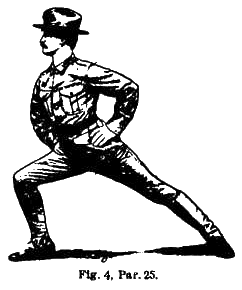
|
heels on a line perpendicular to the front; body inclined slightly forward; shoulders back, bead erect and turned to the front. At the command guard, quickly bend the left knee, slightly straighten the right, raise the right heel, draw back the right leg, and firmly resume the position of guard.
Being in the position of lunge the instructor may command 1. First, 2. EXERCISE. At the command exercise, straighten the right leg forcibly, keeping the left leg straight; then resume position of lunge. Repeat at the commands ONE, TWO.
The instructor may also command 1. Second, 2. EXERCISE. At the command exercise, straighten the right leg and bend the left; then straighten the left and bend the right, resuming lunge. Repeat at the commands ONE, TWO. The interval between straightening and bending should be only long enough to admit of thoro action.
|
Continual motion renders the joints supple, but long pauses between motions only serve to stiffen them. Resume guard or attention at command.
The knees must be well prest thru each time; the feet remain flat on the ground. These exercises should be had at the beginning and the end of each lesson. Resume guard or attention at command.
26. As the movements and exercises are mastered the instructor will order them to be executed in combination with preceding ones,
16 SABER EXERCISE ON FOOT
until finally all the movements are executed in quick succession. The intervals between commands will be no longer than is necessary for the execution of movements, and the instructor will vary the order of movements as much as possible. Combinations of movements may be arranged at the discretion of the instructor, the execution to begin at a command or signal. At this stage of the instruction the men should frequently be formed in two lines facing each other, with a distance of about two yards between the lines; one line is named No. 1, the other No. 2. This will afford opportunity for mutual observation and for alternation in the rests.
When a movement is to be executed by one of the lines and the other line is to execute a corresponding movement or to stand fast, the command will state the number of the first line.
When the same movement is to be executed by both lines, the commands will be the same as for a single line. All the movements heretofore explained for one line may be executed at the same time by both lines, except that as one line advances the other will be required to retire.
ARTICLE II.
MANUAL OF THE SABER.
27. The instruction under this head is given to squads of four or more men placed in single rank or line on fool The scabbard is hooked up, unless otherwise prescribed. When marching in double time the drawn saber is carried at port. and the left hand steadies the scabbard.
28. The instructor points out and names the different parts of the saber, scabbard, and saber knot (par. 8); he also explains such of the definitions as are necessary (par. 10).
29. 1. Draw, 2. SABER.
At the command draw, unhook the saber with the thumb and first two fingers of the left hand, thumb on the end of the hook, fingers lifting the upper ring; pass the right hand thru the saber knot and push the sliding loop up to the wrist with the left hand; grasp the scabbard with the left hand at the upper band, bring the hilt a little forward, seize the gripe with the right hand, and draw the blade 6 inches out of the scabbard, pressing the scabbard against the thigh with the left hand.
At the command saber draw the saber quickly, raising the arm to its full extent to the right front, at an angle of about 45 degrees; the saber,
SABER EXERCISE ON FOOT 17
edge down, in a straight line with the arm; make a slight pause and bring the back of the blade against the upper arm, edge to the front, arm nearly extended, hand by the side, elbow back, third and fourth fingers back of the gripe; at the same time hook up the scabbard with the thumb and first two fingers of the left hand at the upper ring; drop the left hand by the side. This is the position of carry saber, dismounted.
The following movements are executed from the position of carry saber:
30. 1. Present, 2. SABER.
Carry the saber to the front, base of the hilt as high as the chin and 6 inches in front of the neck, edge to the left, point 6 inches in front of the hilt, the gripe in the full grasp.
1. Carry, 2. SABER. Resume position of carry saber.
31. 1. Inspection, 2. SABER.
Take the position of present saber, (TWO) Turn the wrist to the right, the hand remaining in position; at this same time relax the grasp and turn the saber to the right between the thumb and finger, so as to show the other side of the blade. (THREE) Resume carry saber.
18 SABER EXERCISE ON FOOT
32. 1. Port, 2. SABER.
Place the right hand in full grasp in front of the hip and at the height of the waist, the blade edge to the front, directed diagonally to the left front, the point in front of the left shoulder.
1. Carry, 2. SABER. Resume the position of carry saber.
 |
33. 1. Return, 2. SABER.
At the command return, carry the right hand in front of and 6 inches from the left shoulder, the saber vertical, edge to the left; at the same time unhook and lower the scabbard with the left hand, supporting the upper ring on the middle finger, the thumb and forefinger holding the scabbard above the ring, the arm extended, the hand turned outward; turn the head to the left, fix the eyes on the mouth of the scabbard, raise the right hand vertically and lower the blade, passing the back across and along the left arm, point to the rear, insert the blade 6 inches in the scabbard and turn the head to the front.
At the command saber, with a quick movement send the saber to the hilt into the scabbard, free the wrist from the saber knot and drop the right hand by the side; hook up the saber, turning it toward the body, guard to the rear, and drop the left hand by the side. |
 |
34. The squad is rested as without arms.
Being at carry saber: 1. Parade, 2. REST.
Take the position of parade rest, dropping the point of the saber so that it will be on or near the ground in front of the center of the body, edge of the blade to the right.
At the command attention, resume the position of the soldier and return to carry saber.
SABER EXERCISE ON FOOT 19
35. DISMISSED: This command is given with the squad in rank and sabers in the scabbards.
For officers and for noncommissioned officers
out of rank armed with the saber.
36. At the command order, arms, drop the saber to the front, point on or near the ground, edge down, gripe in full grasp, arm extended. This is the position of order saber.
The rifles of the command being at the order, if any portion of the manual of arms other than present or parade rest is executed, the saber is brought to the carry.
37. Being at the carry or order: 1. Present, 2. SABER (ARMS).
At the command present, officers execute present saber (Par. 30).
At the command saber (arms), officers lower the saber, point in prolongation of the right foot and near the ground, edge to the left, hand by the aide, thumb on left side of gripe, arm extended. Non commissioned officers execute present saber at the command saber (arms), as prescribed in paragraph 30.
38. Being at the carry or order: 1. Parade, 2. REST. Take the position of parade rest, the point of the saber on or near the ground, in front of the center of the body, edge of the blade to the right.
To resume the attention command: ATTENTION.
39. At ceremonies, officers, and noncommissioned officers, with saber drawn, execute present saber, carry saber, parade rest and order saber.
While reading orders, the saber may be held suspended by the saber knot at the wrist.
20 SABER EXERCISE ON FOOT
ARTICLE III.
CIRCLES, MUOULINETS, AND
SIMPLE PARRIES, CUTS, AND THRUSTS.
40. The men, armed with the saber, are formed in one line with intervals of 3 yards. The sabers are then drawn and scabbards hooked up (par. 29). The instructor commands:
1. GUARD.
At the command guard, the feet, legs, and body move as in paragraph 15; raise the right arm toward the front and bend it so that the elbow will be about 4 inches from the body, the right hand,
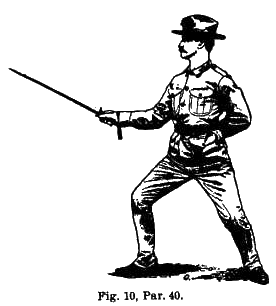
|
in tierce, at a height halfway between the right shoulder and the waist. The right hand and elbow should be in the vertical plane to the front passing through the right hip. The point of the saber is placed at the height of the chin and in front of the left eye, edge of the blade to the right and slightly upward. At the same time unhook the scabbard with the left hand, grasp it between the rings, back of the hand out ward, turn the hand inward, and place the left wrist across the small of the back. When no scabbard is worn, the left wrist occupies the same position.
This guard is also known as the right guard; it is the guard commonly used and the one to be taken at the command guard, which may be given in any position of the body or the saber.
41. To change to the left guard, the instructor commands: 1. Left. 2. GUARD.
|
The hand is quickly turned in carte and shifted to the correspond in position in front of the left side, edge of the blade to the left, point opposite the right eye. The original guard is resumed at the command guard.
SABER EXERCISE ON FOOT 21
From either position of guard: 1. Carry. 2. SABER.. Resume position of paragraph 29.
42. All the leg movements are executed as without arms (pars.15 to 25, inclusive). Care must be taken not to derange the position of the saber. The movements should be solely leg movements, the hand and saber being moved as little as possible. Practise should be continued until the desired stability is attained.
The circles, moulineta, parries, cute, thrusts, and combinations thereof are taught from guard, but they may be executed from any position.
Circles and moulinets.
43. What the leg exercises are to the legs the circles and moulinets are to the arms; they give suppleness and strength to the wrist, and thus increase the skill and confidence of the soldier They are executed from guard and should be frequently repeated, each drill beginning and terminating therewith. The movements should be made with a quickness proportioned to the progress of the men, remembering that force is less necessary than skill.
22 SABER EXERCISE ON FOOT
44. 1. Left, 2. LEFT
Raise the extended right arm to the front until the hand, in tierce,
is at the height of the forehead blade in prolongation of the arm. (TWO) Move the point to the left, describe a horizontal circle and finish with the hand in carte, edge of the blade to the left. (THREE) Resume initial position.
45. 1. Right, 2. CIRCLE.
Raise the extended right arm to the front until the hand, in carte, is at the height of the forehead. (TWO) Move the point to the right and describe a horizontal circle, finishing with the hand in tierce, edge of blade to right. THREE) Resume initial position.
46. The moulinets are circles approximately vertical, and in the case of mounted troops are supposed to clear an imaginary horse's head and neck.
1. Left. 2. MOULINET.
Extend the right arm to the front and slightly to the left, the hand in tierce and as high as the forehead point of the saber in front of the left shoulder and a little higher than the hand. (TWO).
SABER EXERCISE ON FOOT 23
Lower the blade, edge to the front and describe a vertical circle, finishing with hand in tierce. (THREE) Resume Initial position.
47. 1. Right, 2. MOULINET.
Extend the right arm to the front, hand in carte and as high as the forehead, the point in front of the right shoulder and a little higher than the hand.
 |
(TWO)Lower the blade, edge to the front, and describe a vertical circle, the blade passing close to the right elbow. (THREE) Resume initial position.
48. 1. Left and RIGHT (Right and Left). 2. MOULINET.
Execute the first motion of left (right) moulinet. (TWO) Execute the second motion of left (right) moulinet, and, without pausing, move the hand, turn the wrist and execute the second motion of right (left) moulinet. (THREE) Resume initial position.
49. 1. Rear, 2. MOULINET.
Raise the arm to the right and rear to its full extent, point of the saber upward, edge to the right, body turned slightly to the right.
(TWO) Move the point to the left and describe a vertical circle in rear of the body. (THREE) Resume Initial position. |

|
50. In executing circles and moulineta the right arm should be kept as steady as possible, the saber being controlled by movements of the hand and wrist.
The instructor may repeat the command two and cause the second motion of circles and moulinets to be repeated.
51. When the men execute the circles and moulinets well the instructor causes them to execute several in succession without pausing. For this purpose the commands: 1. Continue the motion, 2. Left (or Right), 3. Circle, or 2. Left (or right, or rear, or left and right, or right and left). 3. MOULINET, 4. GUARD.
24 SABER EXERCISE ON FOOT
Parries.
52. The parries are intended to ward off the cuts and thrusts of the adversary. The cuts should be received on the heavy part of the blade and so that the opposing blade will slide toward and be stopt by the hilt. The nearer the hilt a blow is received the less force is required to deflect or stop it.
The parries are habitually executed from the guard, but should also be taught from the left guard and from every position of cuts, thrusts, feints, and parries. They should be made quickly, the hand moving only as far as necessary to afford cover. The position of the hand and saber in the different parries will vary somewhat according to the direction of the cut.
SABER EXERCISE ON FOOT 25
The parries for the thrusts are the same as for cuts except that less movement is required to deflect the adversary's blade.
53. 1. Tierce, 2. PARRY. Carry the hand and saber quickly, so as to cover the right arm and shoulder, point in the plane of the right shoulder. (TWO) Resume guard.
 |
54. 1. Carte, 2. PARRY. Turn the hand in carte and carry it slightly to the left, so as to cover left arm and shoulder. (TWO) Resume guard.
Low tierce parry and low carte parry are executed in the same way as tierce parry and carte parry, except that the point is lowered to the height of the belt.
55. 1. Head, 2. PARRY.
Raise the hand in front of the right shoulder a little higher than the head, arm slightly bent, the blade, edge up, pointing diagonally to the left, forward and upward. The hand should be moved so as to parry according to the direction of the attack (TWO) Resume guard. |
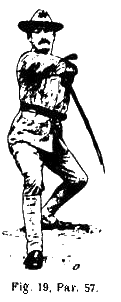 |
56. 1. Left High. 2. PARRY.
Turn the hand in carte and carry it to the left and a little higher than the head; upper arm horizontal, forearm nearly vertical; edge of blade to the left, pointing diagonally forward. upward, and to the right, the heavy part of the blade covering the head. (TWO) Resume guard.
This parry should he used with caution and to a limited extent only.
57. 1. Left Low, 2. PARRY.
Raise the arm, nearly straight, and at the same time move it to the left so that the hand in tierce will be at the height of the chin, the point downward and forward, the edge to the left the left side of the body. (TWO) Resume guard.
26 SABER EXERCISE ON FOOT
Combination parries.
58. After the simple parries are well understood and properly executed, commands may be given for combination parries; for example:
1. Head and Left High, 2. PARRY.
Execute quickly the first motion of head parry and pass at once to the first motion of left high parry. (TWO) Resume guard.
In this manner a number of combinations may be executed. It is advisable in the beginning to combine only two; later, three or four may be combined in one command.
The simple and combined parries should also be practised in combination with the leg movements, except the lunge; for example:
1. Advance and Head. 2. PARRY.
1. Retire and Left Low, 2. PARRY.
Etc., etc.
Cuts — General Principles.
59. The cuts are divided into long cuts and short cuts. In the former the cut proper is preceded by a swing of the forearm and saber, the point describing the arc of a circle of which the elbow joint is the center; the upper arm is moved as little as possible.
The force of the cut may be increased by a movement of the wrist from the thumb toward the little finger. In the short cuts the hand and saber are already in proper position for executing the cut, and, at most, only a slight preliminary movement is made before executing the cut, which results principally from a motion of the wrist. The short cuts are generally directed against the arm of the adversary.
The cuts are habitually executed in connection with the extension (par. 24). After the correct positions are acquired, the cuts should frequently be practised in combination with the advance, the retire, and the lunge, pursuant to command.
The long cuts are first made with large swings, but alter the men learn to deliver the cuts truly and with precision the swings are reduced until they assume the quick and practical form required. As the long cuts uncover the body they must be used with caution.
Cuts delivered from above are called head or high cuts; they may be vertical, right oblique, or left oblique. Cuts against the right side are called tierce cuts, against the left side, carte cuts. They may be classified as horizontal, high, and low.
SABER EXERCISE ON FOOT 27
60. 1. Front, 2. CUT.
Swing the blade to the left and over the head; upper arm nearly vertical; elbow well bent, forearm pointing to the rear, blade in prolongation of forearm, edge up. (TWO) Straighten the arm energetically and strike the head of the adversary, edge of blade down, hand at the height of the eyes. (THREE) Resume guard.
61. 1. Left High, 2. CUT.
First motion same as for front cut, except that the hand is a little out from the shoulder, point slightly to the left rear. (TWO) Cut at left side of head or neck of adversary. (THREE) Resume guard.
62. 1. Right High, 2. CUT.
First motion same as for front cut, except that the wrist is turned slightly inward, the point to the right rear. (TWO) Cut at right side of head or neck. (THREE) Resume guard.
63. 1. Carte. 2. CUT.
Swing the saber to the left over the head, the elbow well bent, the hand to the right of the right shoulder, blade pointing to the right rear, edge to the front, point a little higher than the head. |
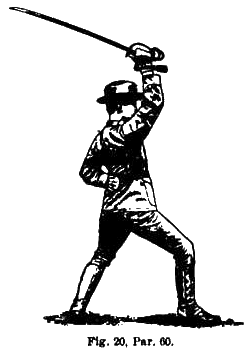 |
(TWO) Straighten the arm with energy, making a horizontal cut to the left and stopping with the hand in carte in front of the right shoulder. (THREE) Resume guard.
64. 1. Tierce, 2. CUT.
Turn the hand quickly in carte, drop the point and swing the saber to the rear and over the head; stop the hand to the left of the head, forearm pointing to the left rear blade in prolongation of the forearm, edge to the front, pointing a little higher than the head. (TWO) Straighten the arm with energy and make a horizontal cut to the right, the hand in tierce stopping in front of the right shoulder. (THREE) Resume guard.
28 SABER EXERCISE ON FOOT
By prefixing the words high or low, or designating the parts to be hit, the cuts in carte and tierce may be made against any part of the body from knee to shoulder.
65. When the cuts are properly executed combinations may be made of parries followed by cuts, and of cuts followed by parries, as:
1. Head parry and right high, 2. CUT.
2. Left high parry and tierce, 2. CUT.
3. Front cut and head, 2. PARRY.
4. Tierce cut and Right, 2. PARRY.
66. To combine leg movements with cuts, commands may be given as follows:
1. Advance and tierce, 2. CUT.
2. Advance, lunge, and tierce, 2. CUT.
3. Lunge and tierce, 2. CUT.
4. Retreat and front, 2. CUT.
Etc., etc.
SABER EXERCISE ON FOOT 29
Practise all the cuts in connection with the lunge, care being exercised that the lunge and cut are completed at precisely the same instant. If this is done, the adversary will receive the combined force of the cut and the forward movement.
Thrusts.
67. The thrusts are of special importance. They are more quickly executed, generally more effective, and more difficult to parry than the cuts. It is not advisable to attempt complicated thrusts with the saber. A few simple movements, acquired so as to be dexterously and precisely executed, are to be preferred. The point may be used to advantage against an adversary who does not keep himself well covered; against one who rushes in and doing so exposes himself; as a time thrust against one who is slow in delivering his attack; or as a return to a cute or thrust, and in connection with feint of cut.
The thrusts are habitually executed with extension (par. 24), but
30 SABER EXERCISE ON FOOT
frequent practise should be held in combination with the advance, retire, and especially the lunge.
68. 1. Tierce. 2. THRUST.
Quickly raise the hand to the height of the chin and turn the back thereof to the left; edge of the blade up, point as high as the breast (TWO) Straighten the arm, thrust to the front and extend (par. 24), the point aimed at the adversary's breast, the hand as high as the forehead.
(THREE) Resume guard.
69. 1. Carte, 2. THRUST.
Turn the hand quickly in carte and raise it to the height of the
shoulder, edge of the blade to the left, point as high as the breast. (TWO) Thrust to the front of the breast of the adversary; at the same time extend (par. 24) and raise the hand as high as the forehead. (THREE) Resume guard.
Low tierce and low carte thrust are similarly executed, the point being directed at the adversary's waist.
70. When the thrusts are well understood they should be combined with the parries; for example:
1. Head parry and tierce. 2. THRUST.
2. Carte parry and carte. 2. THRUST.
Etc., etc.
SABER EXERCISE ON FOOT 31
Awkward combinations should be avoided.
In order to attain the highest degree of accuracy in lunging, first extend the arm and then execute the lunge. The force of impact depends upon the force of the lunge, not on the strength of the arm.
ARTICLE IV.
SABER EXERCISE IN TWO LINES
71. The saber exercises in two lines consist principally of combinations of cuts, thrusts, parries, and leg movements executed at command, the opponent replying with suitable parries and returns.
Such exercises form the transition to the exercises at will; the latter should not be permitted until the instructor gives orders to that effect.
The desired movements )f attack and defense having been explained, the preparatory command will state the movements for the attack, and the command ASSAULT becomes the signal for execution. At the conclusion of each attack, guard is resumed as quickly as possible without further command.
72. The men, equipped with special sabers, masks, plastrons, and gauntlets, are formed in two lines facing each other, with intervals of three yards between files and a distance of about two yards between the lines.
One line is designated as Number One; the others. Number Two. The instructor will cause the corresponding files to take position exactly opposite each other.
73. 1. Prove, 2. DISTANCE.
Execute left half face, extend the arm and saber horizontally to the front, edge of blade to the right, and take distance, the point just touching the opponent's hilt.
The Engagements.
74. Both lines being at the guard, to engage, No. 1 and No. 2 cross sabers, edge against edge, 8 to 12 Inches from the point. The engagement is tierce when the back of the hand is up, edge of the blade to the right, and the adversary's blade is kept to the right. The engagement is carte when the hand is in front of the left breast, back down, edge of blade to the left, point at the height of and In front of the right eye, and the adversary's blade Is kept to the left. The engagement in tierce is generally the better, because the more natural and lees tiresome position to hold the saber.
32 SABER EXERCISE ON FOOT
Being at the guard :
1. No. 1 Tierce, 2. ENGAGE.
1. No. 1 Carte, 2. ENGAGE.
When No. 1 engages, No. 2 covers, taking the same engagement.
When changing the engagement, the point is dropt just enough to pass under the adversary's blade, at the same time turning and shifting the hand; the adversary then turns and shifts his hand so as to cover.
75. 1. No 1, 2. AD--VANCE.
Execute as in paragraph 16, without crowding and with the least possible movement of the blade. No. 2 executes retire. The movement is reversed at the command 1. No. 2, 2. AD-VANCE.
Cuts, Thrusts, and Parries.
76. After some practise with the simple extension (par. 24), the cuts and thrusts should generally be executed in connection with the lunge. The instructor may caution with lunge, or may cause it to he understood that until further orders cuts and thrusts will be executed accompanied by the lunge.
2. Front cut,
2. Left high cut,
2. Right high cut,
2. Carte cut,
2. Tierce cut,
1. No. 1. 2. Low Carte, cut, 3. ASSAULT.
2. Low tierce cut,
2. Tierce thrust,
2. Carte THRUST,
2. Low tierce THRUST,
2. Low carte THRUST,
No. 1 executes the cut or thrust and No. 2 parries; conversely, at command, No. 2 cuts or thrusts and No. 1 parries.
Short Cuts.
77. The instructor will now teach the men the short cuts$#151;that is, cuts executed with the smallest possible movement of the blade. In order that these cuts may be delivered with force the following movements must be properly executed: Raise the hand, pivoted on
SABER EXERCISE ON FOOT 33
the wrist, just high enough for the point to clear the adversary's point; then, by a forcible extension of the arm and quick bending at the wrist, deliver the cut., accompanied by a lunge. These movements are the same for all short cuts and are of great importance, as they afford the least possible chance of detection. The short cuts are also valuable as returns.
Simple Feints.
78. In order to draw the adversary out and induce him to expose that part of his body on which the attack is to be made, It is advisable to execute the feint with a circular movement and then make the cut or thrust with the shortest possible movement. The instructor may command: 1. No. 1, 2. Feint front, and left high cut, 3. ASSAULT. No. 1 executes the feint arid then the cut with lunge. No 2 executes both parries. Care should be exercised that the blades do not touch while feinting and that the lunge is not executed until the cut is to be made.
Examples of simple feints:
1. Feint left high, and right high cut, ASSAULT.
2. Feint right high, and left high cut, ASSAULT.
3. Feint front, and left high cut, ASSAULT.
4. Feint low Carte, and low tierce cut, ASSAULT.
5. Feint front cut, and tierce thrust, ASSAULT.
6. Feint low tierce cut, and low tierce thrust, ASSAULT.
Etc., etc.
Double feints.
79. In double feints first one portion of the body and then another is threatened, and a third is attacked.
The instructor commands:
1. No. 1, 2. Feint left and right high, and left high cut, 3. ASSAULT. No. 1 feints left high, then right high cut, and then makes a cut at left high with lunge; No. 2 executes three parries.
Examples of double feints.
1. Feint front and left high, and right high cut, ASSAULT.
2. Feint tierce and Carte, and right high cut, ASSAULT.
3. Feint low carte and low tierce cut, and tierce thrust, ASSAULT.
Etc., etc.
34 SABER EXERCISE ON FOOT
Returns.
80. At this stage the instructor will introduce combinations involving the return (counter attack). With beginners all the movements will be explained to the extent deemed necessary, and then executed at the command ASSAULT. Commencing with simple combinations the in2truction will progress to the more complicated; for example:
1. No. 1, front cut. 2. No. 2, return left high cut. 3. ASSAULT.
No. 1 executes front cut, No. 2 parries and immediately returns with left high cut, which No. 1 parries; both numbers then resume guard. In these exercises the endeavor is made to deliver the return before the one making the attack can recover from the lunge and parry the return.
81. Examples of combinations of two cuts:
1. Left high cut, return right high cut.
2. Carte cut, return right high cut.
3. Tierce cut, return left high cut.
Etc., etc.
82. Examples of combinations of three cuts:
1. Left high cut, return right high cut, return carte cut.
2. Right high cut, return right high cut, return right high cut.
3. Carte cut, return front cut, return left high cut.
Many other combinations may be made.
The leading number makes the first cut and the second return; each cut should be parried.
83. In the same manner cuts and thrusts may be combined, and single and double feints should frequently form part of the combination. The commands, for example, would be as follows:
1. No. 1, 2. Feint tierce cut, and low tierce thrust, 3. No. 2, 4. Return front cut, 5. ASSAULT.
1. No. 2, 2. Feint left high cut and front cut, and tierce thrust, 3. No. 1, 4. Return right high cut, 5. ASSAULT.
Indirect Thrusts.
84. In these exercises the attack is made by changing the point. Being at carte engage: 1 No. 1, 2. Disengage and tierce thrust, 3. ASSAULT.
At disengage the point is quickly changed to the side opposite the engagement by moving it under No. 2s blade and the thrust is delivered on that side. No. 2 parries with carte, low carte, or left parry. Similarly from the tierce engage.
SABER EXERCISE ON FOOT 35
The disengage may be double. For example, being at tierce engage: 1. No. 1, 2. Feint disengage, disengage at carte thrust, 3. ASSAULT.
No. 1 feints the disengage and, upon No. 2's parry, disengages again and thrusts. Similarly from carte engage.
Feint in Line and Disengage.
85. Being at tierce engage:
1. No. 1, 2. Feint in line, disengage and carte thrust, 3. ASSAULT.
No. 1 extends his arm as if to lunge in the line of engagement, and when No. 2 opposes, changes his point under No. 2's blade and lunges In the high line on the opposite side. No. 2 opposes by moving his blade Slightly to the right and then parries carte or left low. Similarly from carte engage.
Disengage and Thrust Low.
86. Being at carte engage:
1. No. 1, 2. Disengage and low carte thrust, 3. ASSAULT.
No. 1 disengages rather high and upon parry by No. 2 drops the point and thrusts low. No. 2 parries carte and kit low. Similarly from tierce engage.
The low thrusts may also be executed from double or feint of disengage.
ARTICLE V.
SABER EXERCISE AT WILL
87. When the combinations of the preceding articles are executed with sufficient skill the instructor will devise longer ones or courses at arms to be memorized and executed at the command ASSAULT. The accuracy and celerity of the movements will be carefully watched by the instructor with a view to correction of faulty execution.
88. Satisfactory progress having been made, the Instructor will proceed to the exercise at will, by which is meant combats between two men, each endeavoring to hit the other and to avoid being hit himself. This object will generally be beet accomplished by performing the various movements In the manner prescribed.
36 SABER EXERCISE ON FOOT
89. The instructor can supervise only one pair of combatants at a time. Frequent changes should be made, so that the men may learn from each other. A strong and skilful opponent will inspire caution, whereas with a weaker one more vigorous action is indicated, and the recognized superiority imparts coolness and confidence, which are valuable qualifies in combat.
90. The assault should simulate as closely as practicable the conditions of actual combat and should be entered into with caution, the guard being assumed before the adversary comes within reach.
The combat must not begin until the instructor commands GO, after which either party has the right to attack. To stop the contest the instructor will command HALT, at which the combatants will immediately come to attention and then remove their masks.
The instructor will closely observe the contest and decide doubtful points. He will at once stop the combat upon the slightest indication of temper. After conclusion of the combat he will comment on the action of both parties, point out errors and deficiencies, and explain how they may be avoided in the future.
RULES FOR EXERCISES AT WILL.
91. (a) Begin the contest with simple, careful movements, with a view to forming a correct opinion of the adversary; afterwards, everything will depend on quick perception of the adversary's intention, coolness, and rapid and correct execution of the movements.
(b) When It Is necessary to stop the contest, for example, because of breaking of weapons or displacement of means of protection, take the position of carry saber.
(c) Alter receiving a fair hit, a return is not permitted.
(d) Continual retreat from the adversary's attack and frequent dodging to escape cuts or thrusts should be avoided.
(e) Maintain position on the directing line and at normal distance -never nearer than short distance,.
(f) Do not attack until the adversary is ready and in condition to defend himself.
(g) Upon receiving a cut or thrust call out "Hit." Grazing thrusts and hits with the fiat of the blade do not count.
HINTS FOR INSTRUCTORS.
92. All the prescribed movements, both simple and in combination, must be executed with the greatest precision.
SABER EXERCISE ON FOOT 37
The instructor must be master of his weapon, not only to show the various movements, but also to lead in the exercises at will. He should stimulate the zeal of the men and arouse pleasure in the work.
The character of each man, his bodily conformation, and his degree of skill must always be taken into account. When the instructor is demonstrating the combinations Feints, and returns, the rapidity of his attack should be regulated by the skill of the pupil, and no more force than is necessary should be used. Lithe pupil exposes himself too much in the feints and parries, the instructor will, by a cut or thrust, convince him of his error; but if these returns be too swiftly or too strongly made, the pupil will become too cautious and the precision of his attack will be Impaired. The object is to teach the pupil, not to give exhibitions of superior skill.
Occasionally the instructor will leave himself uncovered and fall to parry, In order to teach the pupil to take quick advantage of such opportunities.
GENERAL PRINCIPLES FOR COMBAT.
93. When engaging in an assault, first study the adversary's position and proceed by false attacks, executed with speed, to discover, if possible, his instinctive parries. These false attacks should be given the appearance of real attacks, without, however, coming within reach of the opponent's blade.
When confronted by one who rushes, it is best to retreat until he is under the impression that that is your defense; then wait for the next rush and pin him at the very beginning. This is termed a stop thrust.
Aim at the most exposed part of the body, his sword arm, and If that can not be reached by a direct attack, endeavor to mislead him by making a distinct feint at some part of the body the parry for which exposes the arm, and then cut at the arm with the true or false edge of the blade. For instance, feint low cut, aiming about midway between breast and waist, and at the moment he parries cut at the arm.
Use the time thrust only when your adversary is awkward or too deliberate in delivering his attack. It must be made at the very instant he prepares to attack you, otherwise it is useless.
38 SABER EXERCISE ON FOOT
Deliver your attacks promptly and keep your body well covered by your blade and arm. Do not make cuts with so much force as to carry the hand beyond the body In case no resistance is met. Always maintain a strong opposition and keep your own line of attack well covered.
Endeavor to overcome the tendency of making a return without knowing where it will hit.. Making returns blindly is a bad habit and leads to instinctive returns; that is, habitually returning with certain cuts from certain parries, a condition which the skilled opponent will not be long in discovering.
To sum up: Keep cool; study your adversary and try to discover his game; watch for opportunities and make instant use of them.
If you know your adversary's game, take advantage of it; if not, try to make him play yours.
SABER EXERCISE, MOUNTED 39
PART II
SABER EXERCISE, MOUNTED.
GENERAL PRINCIPLES.
94. In the endeavor to face each other, adversaries on foot generally meet in the directing line. The mounted soldier, however, may be attacked from any direction in which he is not covered b the horse or his equipments, and often can not turn his mount wit sufficient quickness to face the opponent. The cuts, thrusts, and parries must, therefore, be modified so as to be suitable for attack and defense in various directions.
95. On the other hand, many of the saber exercises on foot find no practical application mounted; but they have served to convert the recruit into a swordsman who has acquired strength, skill, a quick eye, and confidence in himself. In the meantime, thru diligent instruction in equitation, the recruit should have become a sufficiently good rider to be able to keep his horse well in hand. This is of such importance that it is sale to say that a good rider who is a weak swordsman would have the advantage over a good swordsman who is a poor rider. Mounted saber exercises should, therefore, not be attempted with men who have not gained confidence on horseback.
96. The saber action of two mounted men during contact will hardly amount to more than a quick thrust or strong cut, with parry and quick return, or a beating or pushing aside of the adversary. blade in order to make a cut or THRUST. Fencing on horseback being generally impracticable, practise in complicated combinations Is unnecessary.
97. Instruction in the use of the saber mounted will at first be given at a halt. When the various movements are well executed, the exercise will be held at all gates and over various kinds of ground. The formation for this purpose will be line with intervals, or column of troopers with distances increased to 2 yards.
40 SABER EXERCISE, MOUNTED
ARTICLE I.
MANUAL OF THE SABER, MOUNTED.
98. When the saber is worn, it is unhooked as the trooper places himself opposite the horse's shoulder, after the command prepare to mount.
Before beginning the manual a few movements may be executed to quiet the horses.
99. 1. Draw, 2. SABERS.
At the command draw, pass the right band thru the saber knot without quitting the reins with the left hand; seize the gripe and draw the blade 6 inches from the scabbard.
At the command saber, draw the saber quickly, raising the arm to its full extent to the right front at an angle of about 450, the saber edge down, in a straight line with the arm; make a slight pause and bring the back of the blade against the tight upper arm, edge to the front, elbow near the body, wrist resting on the thigh without constraint, little anger opposite the gripe. The bridle hand should not be deranged and the right shoulder not thrown back. This is the position of carry saber, mounted.
100. The following movements are executed from the position of carry saber: 1. Present, 2. SABER. Same as in paragraph 30.
101. 1. Port, 2. SABER.
Lower the point of the saber to the left so that the blade, edge to the front, will rest on the left forearm near the wrist; the right hand remains on the thigh.
102. 1. Charge, 2. SABER.
Raise the hand, in tierce, as high as the eye; carry back the right shoulder, elbow to the rear; edge of the blade up, point to the front and as high as the breast.
From the positions of present, port, and charge saber, the carry is resumed at the commands 1. Carry. 2. SABER.
103. 1. Inspection, 2. SABER. Same as in paragraph 31.
104. 1. Return, 2. SABER.
At the command return, raise the right hand to the full extent of the right arm vertically above the right shoulder, saber in prolongation of the arm, edge to the front; make a slight pause, then quickly drop the point of the saber to the front
SABER EXERCISE, MOUNTED 41
toward the scabbard, fix the eyes on the opening of the scabbard, and insert the blade 8 inches in the scabbard; turn the eyes to the front. At the command saber, with a quick movement send the saber to the hilt into the scabbard, free the wrist from the saber knot, and drop the right hand by the aide.
The bridle hand may be used to insert the Point of the saber In the scabbard, when necessary.
ARTICLE II.
MOVEMENTS OF SABER EXERCISE, MOUNTED.
105. The squad is formed in line with intervals of 3 yards; or, with distances, at the commands: 1. Front take distance, 2. MARCH, 3. Squad. 4. HALT.
At the command march, No. 1 of each four moves straight to the front; Not 2, 3, and 4 moves straight to the front In succession at a distance of 4 feet; the command halt should be given when No. 4 has his distance.
To assemble: 1. Form, 2. RANK. Nos. 1 stand fast, Nos. 2, 3, and 4 move up into their places.
42 SABER EXERCISE, MOUNTED
106. The movements may be executed from port saber or from guard. The position of the body is not changed unless prescribed.
1. GUARD.
Move the saber so that the point will be at the height of the chin and in front of the left shoulder, arm half extended, elbow in front of the right hip, hand in tierce and a little
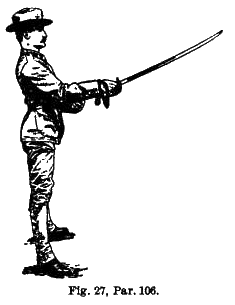 |
higher than the elbow, saber in prolongation of the forearm, edge of the blade slightly lower than the back. This is the normal position of guard, mounted. Resume port or carry at command.
The position of guard, in order to cover the body, must vary according to the direction of the attack. The normal position is taken to meet an attack from the front and slightly to the right. In all cases the eyes must not quit the opponent, and the head and body must be turned in his direction as far as practicable.
For guard to the left, the hand will be in carte; to the left front, hand in tierce, which will favor quick return thrust.
|
Circles and Moulinets.
107. The circles and moulinets, mounted, serve to maintain strength and suppleness of the wrist and to accustom the horse to the saber. They are executed from guard or port saber in the manner prescribed in paragraphs 44 to 51, inclusive. Special be taken to avoid striking the horse.
Parries.
108. 1. Right, 2. PARRY.
Carry the hand quickly a little to the right, point of the saber as high as the eye and opposite the right shoulder, edge to the right so as to cover the right arm and shoulder. (TWO) Resume initial position.
SABER EXERCISE, MOUNTED 43
109. 1. Left, 2. PARRY.
Turn the hand quickly in carte and carry it to the left just above the left forearm, edge of the blade to the left, point to the front, as high as the eye, and a little to the left of the left shoulder, so as to cover the left arm and shoulder. (TWO) Resume initial position.
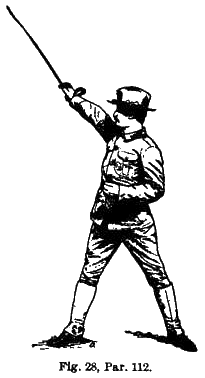 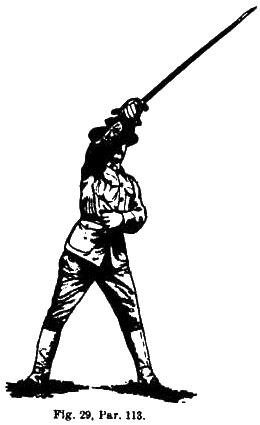
110. Low right parry and low left parry are executed in the same manner as right parry and left parry, except that the point is lowered so as to cover the leg.
111. 1. Head, 2. PARRY.
Executed as in paragraph 55.
44 SABER EXERCISE, MOUNTED
112. 1. Right bayonet. 2. PARRY.
Turn the head to the right, throwing back the right shoulder, raise the saber, arm extending upward to the right and rear, hand in tierce, edge of the blade to the left, point upward. (TWO) Describe a circle on the right with the arm and saber, dropping the point to the rear and bringing it to the front, arm extended; turn aside the bayonet with the back of the blade, finishing with the hand as high as the head, point upward. (THREE) Resume initial position.
113. 1. Left bayonet, 2. PARRY.
Turn the head and shoulders to the left; raise the saber, arm extended upward to the front and left, hand in tierce back of the blade to the front, point upward. (TWO) Describe a circle quickly on the left, from front to rear, parallel to the horse's neck, arm extended; turn aside the bayonet with the back of the blade, bringing the hand, still in tierce, above the left shoulder. (THREE) Resume initial position.
Cuts.
114. All cuts with the hand in tierce, when not executed by the numbers, are terminated with a half moulinet in returning to guard or port in all cuts with the hand in carte the hand remains In carte to the finish and is then quickly returned to the original position. The instructor will insist on perpendicular presentation of the blade to the actual or imaginary surface to be cut before the terminating half moulinet begins.
115. 1. Front. 2. CUT. 1. Right high, 2. CUT. 1. Left high, 2. CUT. Executed as in paragraphs 60, 81, and 62.
116. 1. Left, 2. CUT.
Turn the head to the left, raise the saber, arm extended to the right; hand back down, as high as the head, point higher than the hand. (TWO) Cut diagonally to the left as high as the neck. (THREE) Resume initial position.
117. 1. Right, 2. CUT.
Turn the head to the right, carry the hand opposite the left breast, point of the saber upward, edge to the left (TWO) Extend the arm quickly to its full length and cut horizontally to the right (THREE) Resume initial position.
SABER EXERCISE, MOUNTED 45
118. The front, left, and right cuts may be used against object. on or near the ground and are then made by inclining the body forward, close to the horse's neck, the seat close, knee. and ankles supple, clinging to the horse with the legs and thighs, carrying the bridle hand slightly to the side opposite the cut without checking the horse, and cutting at the proper angle without swaying the body or the horse. They may be
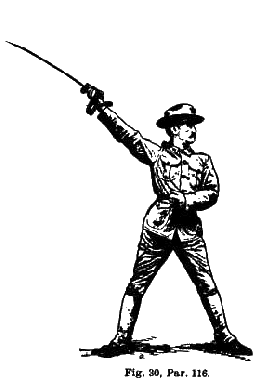 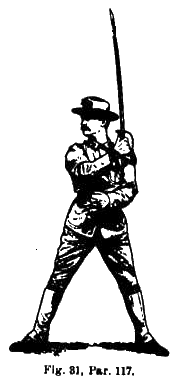
practised by prefixing the word low to the first command; the height of the object may be Indicated by the instructor.
119. 1. Rear, 2. CUT.
Turn the head to the right, throwing back the right shoulder; carry the hand near the left breast, blade vertical, edge to the left. (TWO) Extend the arm quickly to its full length and cut horizontally to the rear in tierce. (THREE) Resume initial position.
46 SABER EXERCISE, MOUNTED
Points.
120. The remarks made in paragraph 67 on the advantages of the thrusts apply with still greater force to the points. With the horse in motion toward the opponent, very little extension of the arm is required, the most important part being to direct the point
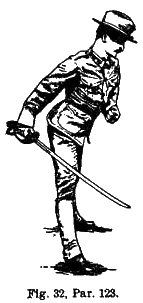 |
quickly and accurately at the adversary. The position of the saber should, as far as practicable, afford cover against cute or points by the opponent.
121. 1. Tierce, 2. POINT.
Execute charge saber (par. 102). (TWO) Thrust to the front, extending the arm to its full extent. (THREE) Resume initial position.
122. 1. Carte, 2. POINT.
Lower the hand, back down, near the right hip, the point a little higher than the hand. (TWO) Thrust to the front, extending the arm to its full length, edge to the left. (THREE) Resume initial position.
123. 1. Front, 2. POINT.
Bend well down to the right, extending the arm well down, the hand in rear of the thigh, back of saber up. (TWO) Thrust forward. (THREE) Resume initial position.
|
124. 1. Left, 2. POINT.
Turn the head and shoulders to the left, draw back the hand in tierce toward the right and near the right shoulder, hand at the height of neck, edge upward, point to the left and as high as the band. (TWO) Thrust to the left, extending the arm to its full length, edge to the front. (THREE) Resume initial position.
125. Right, 2. POINT.
Turn the head to the right, carry the hand in carte near the left breast, edge upward, point to the right and as high as the hand.
(TWO) Thrust to the right, extending the arm to its full length, edge to the front. (THREE) Resume initial position.
126. Front point, left point, and carte point may be used against objects on or near the ground by prefixing the word low to the first command. The action of the trooper is the same as stated in paragraph 118, substituting "point" for "cut."
SABER EXERCISE, MOUNTED 47
127. 1. Rear, 2. POINT.
Turn the head and shoulders to the right and rear, and bring the hand in carte near the left breast, point to the rear and as high as the hand, edge up. (TWO) Thrust to the rear, extending the arm to its full length, edge to the right. (THREE) Resume initial position.
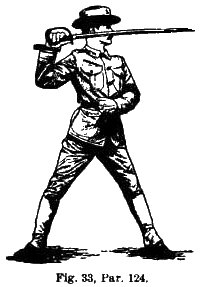 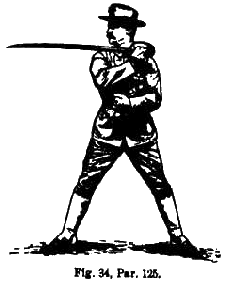
ARTICLE III
RUNNING AT HEADS AND EXERCISES AT WILL.
128. After the troopers have become skilful in the use of the saber on foot, have acquired a good seat and good control of the horse and know the saber exercise mounted, they will practise cutting, and thrusting at heads and rings In the riding hall or on the track, as prescribed in Cavalry Drill Regulations. The object is to give confidence In the use of the edge and point as well am celerity of movement and correct judgment of time and distance.
129. The most important factor of success is the education of the horse. Unless he can be made to go straight and fearlessly, not only at obstacles but also at men, mounted or on foot, and at
48 SABER EXERCISE, MOUNTED
other objects likely to be encountered on the field of battle, the saber will be of no offensive value as an individual weapon. By constant contact in his daily life the horse should gradually become so familiar with dummies, posts, targets, and heads that he will approach them without hesitation, the test of which will be exercises at will on open ground without any track whatever.
130. For the exercises at will, the troopers are formed in two squads facing each other at a distance of about 100 yards. One squad is designated as No. 1, the other as No. 2. The men are armed with special sabers and equipped with masks, etc. At the command: 1. First trooper from the right (or left), 2. MARCH. The designated men move diagonally across the intervening space, meeting midway by the right (or left). They are at first taught the simple attack, parry and return at a walk, progressing to encounters at the trot and gallop, and finally to meeting at will and the attack and defense in pursuit.
131. The rules for exercises at will (par. 91) will apply as far as practicable. The instructor supervises each contest, decides questions arising, corrects errors, and prevents disorder. The command halt or next terminates the contest, the troopers joining the opposite flank of their squads.
The instructor from time to time orders movements to quiet the horses and to occupy those not engaged in contests.
132. Thruout the exercises care must be taken not to strike the horse. The work of a long period of training will be undone if the horse be struck repeatedly, especially about the head.
Mounted Combat.
133. The parries to the left are relatively awkward, and the cute and thrusts have less reach and force than when made to the right. The weakest point is the left rear; an enemy caught In that position should be attacked at once.
It is highly important to maintain at all times the proper position and balance of the body; it should not be deranged by cuts or thrusts to the extent making it impossible to meet quickly a return or an attack from other adversaries.
If the enemy advance prepared to make a long cut, meet him with a thrust; this will take effect before the cut can be made, and the guard will protect the head.
SABER EXERCISE, MOUNTED 49
Should the enemy be approaching from the left rear, halt suddenly and allow him to pass before coming in reach, or turn quickly to the right or right about, thus securing an advantageous position.
When meeting an adversary to the left front, turn sharply to the left or left about, thus bringing him on your right, with your saber arm free.
In pursuit endeavor to gain the enemy's left rear; cut at the hocks if necessary.
When pursued keep the enemy to the right rear, and prevent him from closing by rear cute or thrusts, or by striking his horse's head, the reins, or the bridle hand.
In the mélée continue to cut and thrust with quickness and energy, taking advantage of every opportunity presenting itself.
¤
----------------------------------------------------------
HOME
Contact the webmaster:
Major Dave Gowan
IT Sec HQ SCSG
dgowan@tfn.net
|
